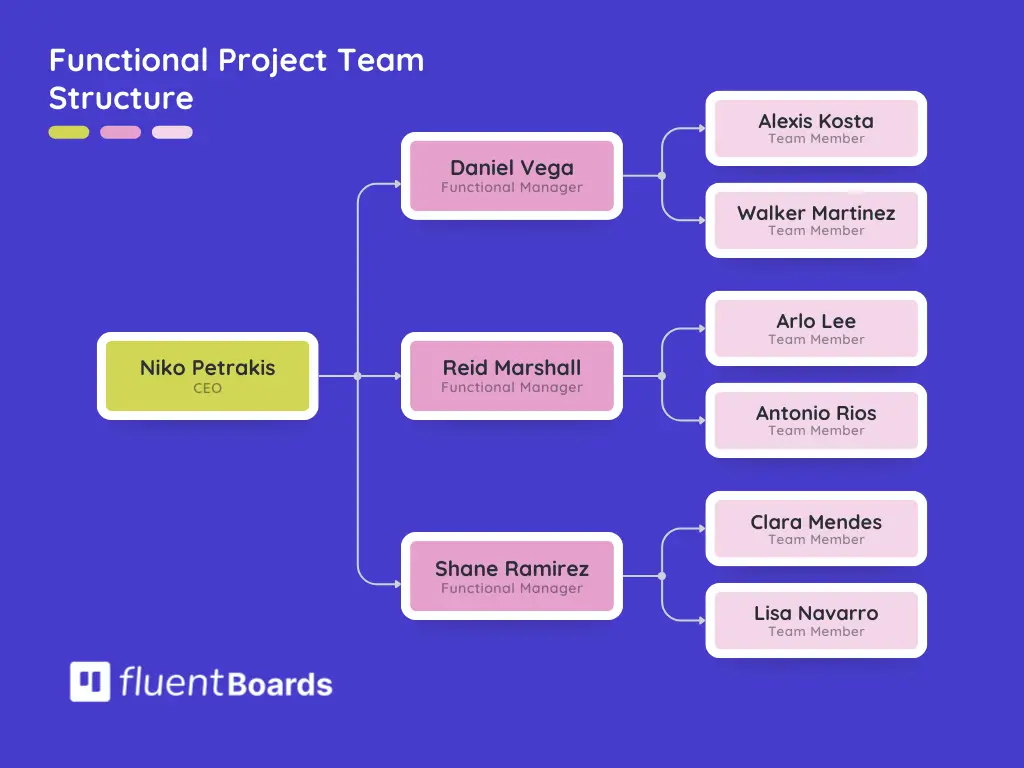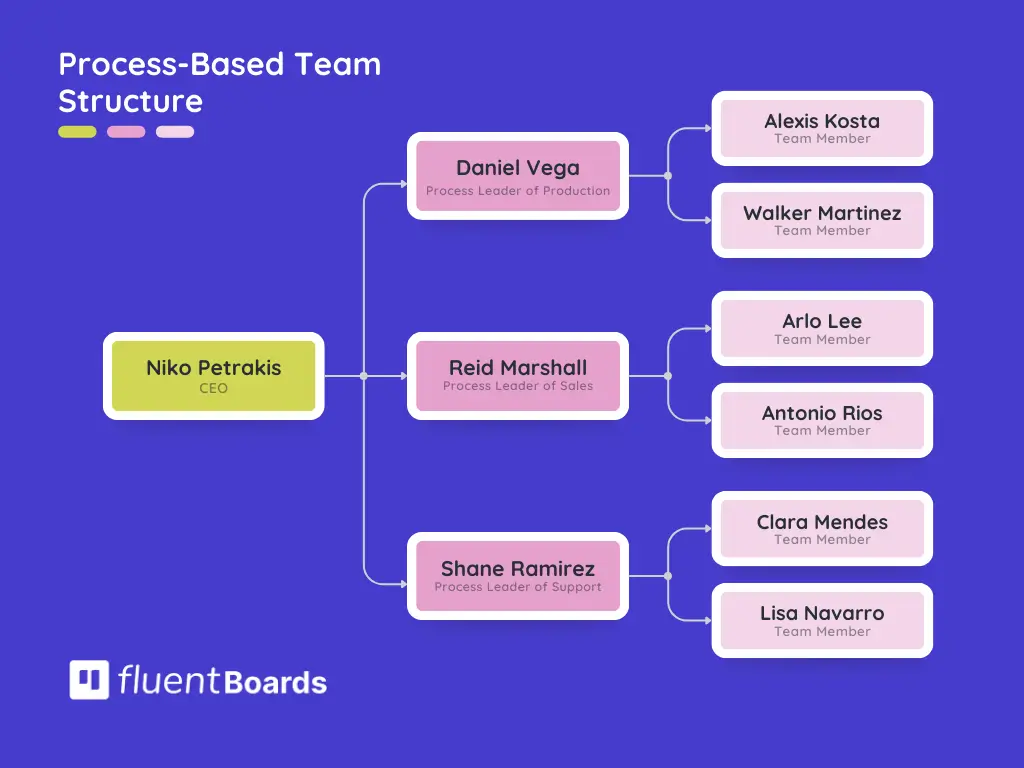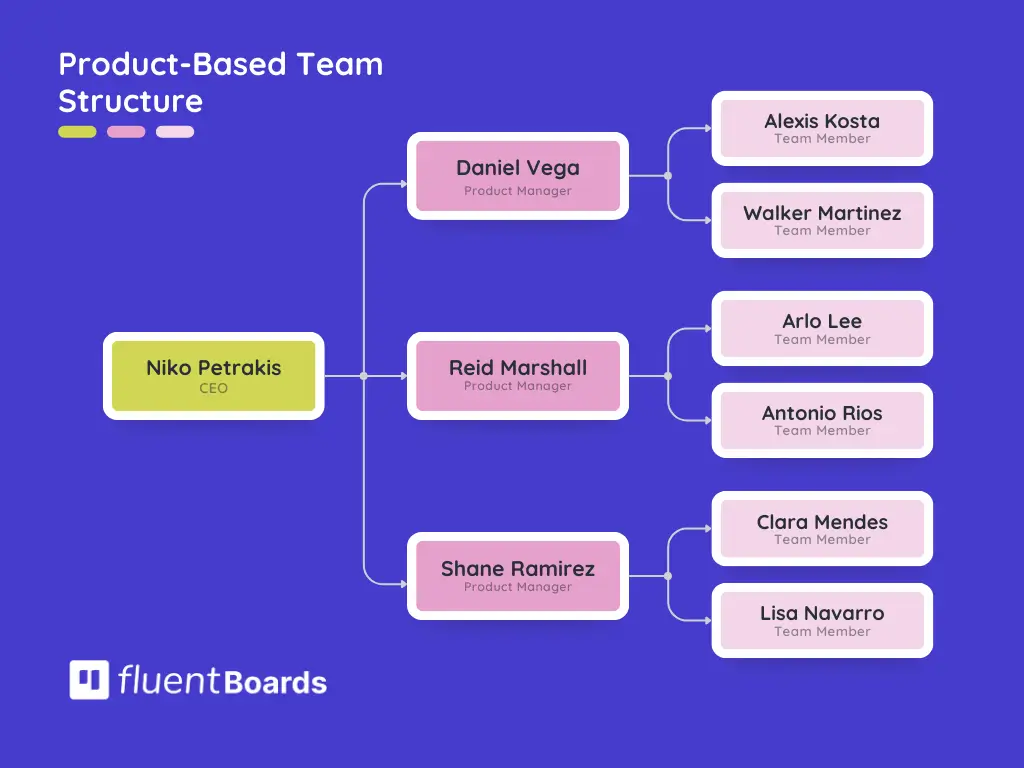
Project Team Structure 101: Everything You Need To Know About Project Management Organizational Structure
You’ve got an amazing project in hand and a list of skilled team members ready to dive in, and you’re all set to take off!
But wait! Have you missed a key step?
Without clarifying who is accountable for what and who will report to whom for updates and necessary changes, wouldn’t the project execution turn into a mess?
And, this is where the importance of having a solid project team structure comes into play. To increase your project’s chances of success, you must first organize your team before making the final moves.
Curious to learn more about project management organizational structures, their types, and how to choose the right one?
Buckle up then—it’s reading time!
What Is the Project Team Structure?
Project team structure refers to how roles, responsibilities, and relationships are organized within a project team. It defines how team members collaborate, who reports to whom, and how decisions are made.
In general, a project team consists of various members with different skill sets. To ensure the team is aligned and succeeds in its mission, it’s important to have a clear, strategic, and structured approach.
And, this is where the project team structure comes in. It aligns everyone and organizes team members by defining their roles, the responsibilities they are accountable for, and who will be the leader or “captain of the ship,” ensuring the team moves forward with purpose and coordination.
Additionally, the team structure impacts how communication flows within the group. Thus, in the long run, it brings transparency, accountability, and a more collaborative environment, where everyone works toward a common goal—not just as individuals, but as a team.

Level up your WordPress project management game with this Trello equivalent solution – where limitless possibilities come at an unbeatable price!
5 Most Commonly Used Project Team Structures
There are various types of project team structures, each suited to specific needs. However, most organizations commonly use one of these five structures to organize their teams:
- Functional project team structure
- Project-based team structure
- Matrix-based team structure
- Process-based team structure
- Product-focused team structure
Let’s dive in and explore each type in detail!
Functional project team structure
The functional project team structure divides the company into departments based on their expertise. Each department is managed by a functional manager who is responsible for the team’s work in that area. These managers report to a top executive like the CEO.

Functional managers provide oversight, manage resources, and ensure that work aligns with the organization’s strategic goals. When projects arise, team members temporarily join the project but continue to report to their functional managers.
This way, the project gets the right skills and knowledge, and the departments maintain a steady flow of work.
Best fit: This structure is ideal for large organizations focused on a limited range of products or services, as it improves consistency and resource efficiency within specialized departments.
Project-based team structure
A project-based structure is a team organization model where employees are temporarily assigned to dedicated project teams to complete specific projects.
These teams are formed by pulling individuals from various departments and are led by a project manager who reports directly to upper management or the CEO.

The project manager has full authority over the team’s activities, roles, and resource allocation to deliver the project on target.
And, once the project is completed, the team may disband, and members return to their original departments or take on new projects, making this structure effective for organizations that need a flexible, goal-oriented approach.
Best fit: This setup works well for small companies, startups, and organizations handling multiple projects simultaneously, where focused teams with clear project goals and authority are essential.
Matrix-based project team structure
In a matrix organization, employees have two managers: one for their function and another for their project. This structure balances specialized expertise with project-specific focus.
Team members work under the shared guidance of both functional and project managers to complete project goals.

This setup encourages teamwork across different departments, allowing organizations to make the best use of their skills and knowledge on multiple projects.
This cross-functional collaboration enables organizations to share expertise across multiple projects. However, clear communication and cooperation between project and functional managers are required to prevent conflicts.
Matrix organizations work in different ways depending on how much power and responsibility each manager has.
Here’s a simple breakdown of the types of matrix organizations:
- Strong matrix: Project managers have more authority over resources and decision-making, while functional managers provide support in a limited role.
- Weak matrix: Functional managers hold more authority, with project managers acting as coordinators or advisors.
- Balanced matrix: Authority is shared between project and functional managers, with decision-making and responsibilities divided equally.
Best fit: This structure suits organizations that manage multiple projects and require team members to collaborate across departments, promoting skill development and flexibility.
Process-based team structure
A process-based structure focuses on core workflows rather than traditional departments. Each major process (like production, sales, or support) operates as an independent unit managed by a process leader who reports to the upper management CEO or executives.

Process-based teams work to make core workflows better. They use individual skills and teamwork to simplify tasks and remove obstacles. This setup works well for industries that need productivity and well-coordinated processes.
Best fit: Process-based structures are highly effective in industries prioritizing efficiency and continuous improvement, as they make it easier to streamline operations and address process-related challenges.
Product-focused team structure
A product-focused structure is organized around different product lines or services, with each product team responsible for all aspects of its specific product.
Each product line has a dedicated team, including managers, designers, marketers, and support staff, who report to a product lead or product manager and, ultimately, to the executive team or CEO.

This setup allows teams to focus deeply on the needs, development, and success of each product, enabling quick responses to market demands and strategic adjustments specific to each product.
Best fit: This structure works well for companies with diverse product lines, as it allows each team to focus entirely on the success and market responsiveness of their specific product.
How to Choose a Suitable Structure for Your Project Team
Deciding on a project management organizational structure and fully committing to it for success requires a clear understanding of all necessary factors and determining what best fits your needs.
That’s why we suggest –
1. Understand your project goals and define a clear workflow
Begin by clearly defining the objectives of your project. Ask yourself –
- Is it a one-time initiative or a long-term endeavor?
- Does it require specialized skills or cross-departmental collaboration?
- What project management workflow does your team prefer to follow?
Having clear answers to these questions will work like magic and guide you toward a structure that aligns with your project’s vision and complexity.
2. Consider your project timeline and budget
The project timeline and budget are vital factors in selecting the appropriate structure. If the project has a tight deadline or requires rapid decision-making, a projectized structure may be the best option.
However, if the project is long-term with a larger budget, a more collaborative structure (like a matrix) may provide the necessary flexibility while ensuring cost control.
3. Decide the roles and responsibilities
First, decide how many individuals you’ll need in your team to execute the project successfully. Also, determine what roles of the project team you want to assign to them.
Remember, this is the most important step to ensure a smooth workflow throughout all the phases of project management.
4. Evaluate your team’s skills and availability
Assess the expertise and availability of your human resources. A functional structure works well if your team members possess specialized skills and need to focus on specific tasks.
On the other hand, a matrix structure is better suited for projects requiring team members to juggle multiple responsibilities.
5. Consider the tools at your disposal
The availability and functionality of tools can play a key role in determining how well a structure performs. That’s why, take stock of the tools and technology available to you.
A handy project management collaboration tool like FluentBoards can streamline communication and task management, making even complex structures manageable.

Step into the Future of Project Management!
6. Account for risk factors
Evaluate the risks associated with your project and choose a structure that helps mitigate them.
For example, a projectized structure may be better for high-risk, high-priority projects because it provides more control and quicker decision-making, while a matrix structure can distribute the risks more evenly across different teams and functions.
7. Match the structure to your needs
Evaluate the pros and cons of each structure (functional, projectized, matrix, etc.) based on your goals, resources, and tools.
Choose one that allows flexibility while maintaining clarity in roles, responsibilities, and reporting lines.
8. Iterate and adapt
Remember, no structure is one-size-fits-all. Start with the one that seems most suitable and be open to adapting as the project evolves.
Regularly review the structure’s effectiveness and make adjustments to ensure it supports your project’s progress.
Note: To enhance your project management journey, explore our blog on project management tips
Importance of Having a Good Project Team Structure
A clear team structure can make the difference between chaos and smooth progress. Here are the advantages that come with a well-structured project team:
- Clear communication keeps the team on the same page, aligns goals, and makes project team management much simpler
- Defined roles and responsibilities help teams focus on tasks, ensuring accountability as well as risk management
- With the help of a structured approach, you can take full advantage of team collaboration by welcoming new ideas, leading to better solutions
- Sharing duties within the team creates a supportive environment where all members feel responsible and deal with project management problems together
- Quick reviews provide feedback, helping team members identify strengths to improve
- An organized project team increases speed, effectiveness, and flexibility by assigning tasks based on skills and availability
- A solid project plan ensures tasks are organized, leading to on-time delivery and cost savings
You can also read: Why Project Management Matters
Develop a Strong Project Team from the Root Level
Your project team structure is like the roots of a tree. When those roots are strong, the whole tree can stand tall, even when storms come out of nowhere.
A clear, cross-functional project team structure will not just help with tasks; it will keep everyone connected, motivated, and ready to reach new goals together.
Thanks for reading this far. Now, it’s time to develop and apply what you’ve learned!
Start structuring your team effectively right away and transform it into a success machine, where achievements come effortlessly and strategically.
Frequently Asked Questions
Have more questions about the project team structure? We’ve got you covered!
Let’s redefine project management with FluentBoards!
Get Tips, Tricks, & Updates
We won’t send you spam.









![how to create a project management workflow [x steps] (2)](https://fluentboards.com/wp-content/uploads/2025/11/How-to-create-a-project-management-workflow-x-steps-2-768x402.webp)





Leave a Reply